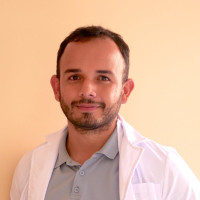Prevention & Personalised Health
Medical Treatment & Drug Development
Genetics & Omics
Clinical Data & Trials
Ph.D
France
2008.09.30
Risk evaluation for recurrent events
Modeling of Health Risks
Biography
I was born in 1985 in Paris. After a scientific baccalaureate, I studied Mathematics and Physics, in preparatory classes for entrance into the French engineering schools. I studied statistics for 3 years at the French National School of Statistics and Analysis of Information. The third year was a specialisation in statistics applied to biology and health, which enabled me to work in the medical field, as I had always hoped for. I also followed a Master’s degree in research in modelling in clinical pharmacology and epidemiology to complement this education.
Research work
The project concerns the statistical methods for analysing data with recurrent events, as frequently observed in clinical research or epidemiologic studies. The aim is to develop methods for evaluating the effect of different factors on the individual risk of recurrence of a given event, and which allow to specify the role of a correlation between the spans of time between consecutive events. Methods for analysing recurrent events are increasingly studied in the biostatistical literature. Most of them are semi-parametric and extend the Cox regression model to the case where each individual may experience several events. The differences between these methods lie in the modelling of the hazard function, in the choice of a timescale, and in the definition of the span of time during which patients are considered at risk for the event of interest.
The project is centred on the conditional “gap-time” model, which is often used for its ease of interpretation. In this approach, the at-risk-period for the jth event is the time since the (j-1)th event. The timescale considers that after an event, the subject starts again at time 0.
For taking into account a correlation between the spans of time between events, an individual random effect (“frailty”), can be included in the model. For mathematical convenience, the frailty term is usually supposed to be distributed according to a gamma distribution with an unknown variance that represents the correlation between the successive events.
A drawback of these approaches is the hypothesis of the gamma distribution for the frailty term, which can alter the results if not verified. The purpose of this work is to develop a “gap-time” approach taking into account a frailty :
- leading to simpler calculation in the case of a gamma distribution
- which can be adapted to other choices of distribution than the gamma.
The method to be proposed will require first the definition of a proportional hazard model where the jth delay depends on a time-dependent covariate that describes the correlation, induced by the frailty, between the (j-1)th and the jth event. The model will be based on the approximation that the variance of the frailty is close to 0. For a gamma-distributed frailty, the model relies on the results of Leffondre & al. For other distributions of frailty, other models will be developed using the same approach. An extension of this first approach will be studied, including in the model of the hazard function (j-1) time-dependent covariates, corresponding to the (j-1) prior periods. The model, applied to the whole sample, will enable to perform a simple Cox regression. Since the interpretation of the frailty term requires a low variance, the accuracy of estimations for different values of the variance will have to be studied. The results of the proposed methods will be compared to those of the usual methods. Simulations of clinical trials and cohorts will be performed to study the properties of the estimators. During the 3rd year of the project, data on leukaemia relapse and those on cystic fibrosis will be analyzed. In cystic fibrosis, a study is designed to researching the risk factors of recurrences of pulmonary Pseudomonas aeruginosa infections in primo-colonised patients. Data will be recorded at the end 2009. In chronic myeloid leukaemia patients, the risk factors of primary and secondary relapse after bone marrow transplantation will be investigated. The availability of the database of the European Bone Marrow Transplantation group is under study. In both cases, biological arguments strongly suggest the existence of a dependence between the times separating two consecutive events.
It is usual in clinical research or epidemiologic studies to try to evaluate the effect of different factors on the risk of a given event. It is more difficult when the events can be recurrent, as it is frequently observed in this kind of studies. The aim of this work is to develop methods for evaluating the effect of different factors on the individual risk of recurrence of a given event, and which allow to specify the role of a correlation between the spans of time between consecutive events. For taking into account this correlation, an individual random effect (“frailty”), can be included in a Cox model. Usually, for mathematical convenience, this frailty is supposed to follow a gamma distribution. The methods proposed here should be adaptable to other choices of distribution than the gamma. These methods should be used in the analysis of two studies with recurrent events :
- In chronic myeloid leukaemia patients, the risk factors of primary and secondary relapse after bone marrow transplantation should be investigated. The availability of the database of the European Bone Marrow Transplantation group is under study.
- In cystic fibrosis, a study is designed to research the risk factors of recurrences of pulmonary Pseudomonas aeruginosa infections in primo-colonised patients. Data will be recorded at the end 2009.
The funding provided by the AXA Research Fund
Above all, this funding makes this project possible since I would not have been able to work for three years without any means of support. Moreover, since it’s a three years long funding, it also enables me to begin this research project without the major inconvenient of not knowing after each year whether I will be able to pursue my work. I am therefore very grateful for this funding.
To add or modify information on this page, please contact us at the following address: community.research@axa.com

Juliette
PENICHOUX
Institution
Institut National de la Santé et de la Recherche Médicale
Paris XI - Paul Brousse
Country
France
Nationality
French
Related articles
Medical Treatment & Drug Development
Terresterial Biodiversity
Agriculture, Crops & Soil Health
Biotech- and Nanotechnology
Insects & Microorganisms
Vaccines
Post-Doctoral Fellowship
Argentina
Harmless and Eco-Friendly Solution as an Alternative to Replace Synthetic Agrochemicals
Agrochemicals were introduced to protect crops from pests and enhance crop yields. However, they have become a long-standing concern due... Read more

Johan
RODRIGUEZ MELO
Instituto de Agrobiotecnología del Litoral
Pollution
Prevention & Personalised Health
Toxic Pollutants & Hazardous Substances
Plastics
Post-Doctoral Fellowship
Luxembourg
Using New Data Sources to Better Manage Substances of Concern (Soc)
In order to put together an accurate risk management process and drive the appropriate regulatory policies, it is necessary to... Read more

Oona
FREUDENTHAL
